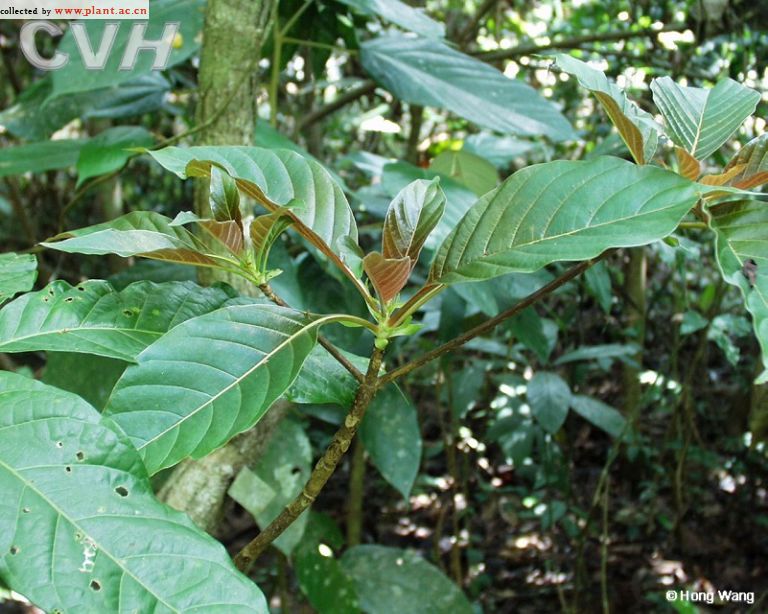毛土连翘Hymenodictyon orixense (Roxb.) Mabberley
毛土连翘Hymenodictyon orixense (Roxb.) Mabberley
2. 毛土连翘(新拟)假黄木、猪肚树(云南河口)、高网膜籽(云南种子植物名录)图版56:6-10
Hymenodictyon orixense (Roxb.) Mabberley in Taxon 31 (1): 66. 1982.——
落叶乔木,高达25米;树皮平滑。叶纸质或膜质,卵状椭圆形或阔椭圆形,长9-22厘米,宽6-14厘米,顶端短渐尖或短尖,基部短尖,全缘,两面被柔毛,在下面较密;侧脉7-10对,在下面凸起;叶柄长2-17厘米,被柔毛;托叶披针形,边常有腺体状齿。圆锥花序大,被柔毛,常下垂,密花,具2-4片叶状苞片;叶状苞片被柔毛,卵形或长圆形,长约9厘米,宽约5厘米,具明显的羽状脉和网脉,柄长5-8厘米,被柔毛;花小,有短花梗;花萼长约2毫米;花冠白色或褐色,长约4毫米。蒴果椭圆形,多数,长1.2-3厘米,宽0.5-1.1厘米,有斑点。花期4-7月,果期4-11月。
产于四川冕宁,云南西双版纳、屏边、河口;生于海拔150-1 700米处的山谷、旷野或河边灌丛中及林中。国外分布于印度、尼泊尔、缅甸、中南半岛、马来西亚、菲律宾、印度尼西亚(爪哇)。
树皮可用作收敛、退热、抗疟药。
《Flora of China》 Vol. 19 (2011)
Hymenodictyon orixense (Roxburgh) Mabberley Taxon. 31: 66. 1982.
毛土连翘 mao tu lian qiao
Cinchona orixensis Roxburgh, Bot. Descr. Swietenia, 21. 1793; C. excelsa Roxburgh; Hymenodictyon excelsum (Roxburgh) Wallich.
Trees, deciduous, to 25 m tall; bark smooth, gray; branches rather stout, weakly flattened to terete, puberulent to densely pilosulous or glabrescent. Leaves often grouped near ends of branches; petiole 2-17 cm, pilosulous; blade drying papery or membranous, ovate-elliptic, elliptic, or broadly elliptic, 9-22 × 6-14 cm, both surfaces pilosulous with pubescence sometimes denser abaxially, base acute to obtuse, margins entire, apex shortly acuminate or acute; secondary veins 7-10 pairs, sometimes with pilosulous domatia; stipules ovate to triangular or lanceolate, 5-20 mm, densely pilosulous, obtuse to acute or bilobed for up to 1/2. Inflorescences terminal and in axils of uppermost leaves, 15-20 cm, simple or branched at least in part, with axes densely spiciform to racemiform, pilosulous, usually pendulous; peduncles ca. 6 cm; basal bracts 2-4, with blade papery to leathery, ovate to elliptic or elliptic-oblong, 9-17 × 2-5.5 cm, pilosulous, with stipe 3-8 cm. Flowers subsessile or with pedicels to 2 mm. Calyx densely puberulent to pilosulous; ovary portion subglobose to ellipsoid, 1-1.5 mm; limb lobed essentially to base; lobes triangular to elliptic, 1-1.5 mm. Corolla white or brown, outside densely puberulent to pilosulous; tube 2.5-3.5 mm, slenderly cylindrical then abruptly inflated at lobes; lobes ligulate to lanceolate, 2-2.5 mm, acute. Style exserted for 2-5 mm. Fruiting pedicels to 10 mm, reflexed. Capsules brown, 1.2-3 × 0.5-1.1 cm, woody, with prominent whitened, elliptic lenticels; seeds (including wing) 7-8 mm. Fl. May-Jul, fr. May-Dec.
Thickets or forests at riversides, at field edges, and in valleys; 100-1700 m. Sichuan, Yunnan [Cambodia, India, Indonesia (Java), Kashmir, Laos, Malaysia, Myanmar, Nepal, Philippines, Thailand, Vietnam].
Mabberley (loc. cit.) noted that Roxburgh studied this species in India as one of several plants (in several families) for which the bitter bark was used medicinally. In India this species is used for good quality wood for furniture and small items, and its bark as a febrifuge and a source of dye (color not noted; Razafimandimbison & Bremer, Bot. J. Linn. Soc. 152: 375-377. 2006).Mabberley (loc. cit.) noted that Roxburgh studied this species in India as one of several plants (in several families) for which the bitter bark was used medicinally. In India this species is used for good quality wood for furniture and small items, and its bark as a febrifuge and a source of dye (color not noted; Razafimandimbison & Bremer, Bot. J. Linn. Soc. 152: 375-377. 2006).
别名:高网膜籽;假黄木;埋怂郭;猪肚木;猪肚树;高网膜仔;
科名:茜草科 Rubiaceae
属名:土连翘属 Hymenodictyon

2. 毛土连翘(新拟)假黄木、猪肚树(云南河口)、高网膜籽(云南种子植物名录)图版56:6-10
Hymenodictyon orixense (Roxb.) Mabberley in Taxon 31 (1): 66. 1982.——
落叶乔木,高达25米;树皮平滑。叶纸质或膜质,卵状椭圆形或阔椭圆形,长9-22厘米,宽6-14厘米,顶端短渐尖或短尖,基部短尖,全缘,两面被柔毛,在下面较密;侧脉7-10对,在下面凸起;叶柄长2-17厘米,被柔毛;托叶披针形,边常有腺体状齿。圆锥花序大,被柔毛,常下垂,密花,具2-4片叶状苞片;叶状苞片被柔毛,卵形或长圆形,长约9厘米,宽约5厘米,具明显的羽状脉和网脉,柄长5-8厘米,被柔毛;花小,有短花梗;花萼长约2毫米;花冠白色或褐色,长约4毫米。蒴果椭圆形,多数,长1.2-3厘米,宽0.5-1.1厘米,有斑点。花期4-7月,果期4-11月。
产于四川冕宁,云南西双版纳、屏边、河口;生于海拔150-1 700米处的山谷、旷野或河边灌丛中及林中。国外分布于印度、尼泊尔、缅甸、中南半岛、马来西亚、菲律宾、印度尼西亚(爪哇)。
树皮可用作收敛、退热、抗疟药。
《Flora of China》 Vol. 19 (2011)
Hymenodictyon orixense (Roxburgh) Mabberley Taxon. 31: 66. 1982.
毛土连翘 mao tu lian qiao
Cinchona orixensis Roxburgh, Bot. Descr. Swietenia, 21. 1793; C. excelsa Roxburgh; Hymenodictyon excelsum (Roxburgh) Wallich.
Trees, deciduous, to 25 m tall; bark smooth, gray; branches rather stout, weakly flattened to terete, puberulent to densely pilosulous or glabrescent. Leaves often grouped near ends of branches; petiole 2-17 cm, pilosulous; blade drying papery or membranous, ovate-elliptic, elliptic, or broadly elliptic, 9-22 × 6-14 cm, both surfaces pilosulous with pubescence sometimes denser abaxially, base acute to obtuse, margins entire, apex shortly acuminate or acute; secondary veins 7-10 pairs, sometimes with pilosulous domatia; stipules ovate to triangular or lanceolate, 5-20 mm, densely pilosulous, obtuse to acute or bilobed for up to 1/2. Inflorescences terminal and in axils of uppermost leaves, 15-20 cm, simple or branched at least in part, with axes densely spiciform to racemiform, pilosulous, usually pendulous; peduncles ca. 6 cm; basal bracts 2-4, with blade papery to leathery, ovate to elliptic or elliptic-oblong, 9-17 × 2-5.5 cm, pilosulous, with stipe 3-8 cm. Flowers subsessile or with pedicels to 2 mm. Calyx densely puberulent to pilosulous; ovary portion subglobose to ellipsoid, 1-1.5 mm; limb lobed essentially to base; lobes triangular to elliptic, 1-1.5 mm. Corolla white or brown, outside densely puberulent to pilosulous; tube 2.5-3.5 mm, slenderly cylindrical then abruptly inflated at lobes; lobes ligulate to lanceolate, 2-2.5 mm, acute. Style exserted for 2-5 mm. Fruiting pedicels to 10 mm, reflexed. Capsules brown, 1.2-3 × 0.5-1.1 cm, woody, with prominent whitened, elliptic lenticels; seeds (including wing) 7-8 mm. Fl. May-Jul, fr. May-Dec.
Thickets or forests at riversides, at field edges, and in valleys; 100-1700 m. Sichuan, Yunnan [Cambodia, India, Indonesia (Java), Kashmir, Laos, Malaysia, Myanmar, Nepal, Philippines, Thailand, Vietnam].
Mabberley (loc. cit.) noted that Roxburgh studied this species in India as one of several plants (in several families) for which the bitter bark was used medicinally. In India this species is used for good quality wood for furniture and small items, and its bark as a febrifuge and a source of dye (color not noted; Razafimandimbison & Bremer, Bot. J. Linn. Soc. 152: 375-377. 2006).Mabberley (loc. cit.) noted that Roxburgh studied this species in India as one of several plants (in several families) for which the bitter bark was used medicinally. In India this species is used for good quality wood for furniture and small items, and its bark as a febrifuge and a source of dye (color not noted; Razafimandimbison & Bremer, Bot. J. Linn. Soc. 152: 375-377. 2006).

